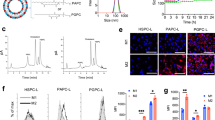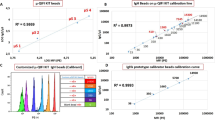Abstract
Selective delivery of cytotoxic anti-neoplastic drugs can diminish the severe side-effects associated with these drugs. Many malignant tumours express high levels of low-density lipoprotein (LDL) receptors on their membranes. Therefore, LDL may be used as a carrier to obtain selective delivery of anti-neoplastic drugs to tumours. The present study was performed to investigate the feasibility of the murine B16 tumour/mouse model for the evaluation of LDL-mediated tumour therapy. LDL binds with high affinity to LDL receptors on cultured B16 cells (Kd, 5.9 +/- 2.3 micrograms ml-1; Bmax 206 +/- 23 ng LDL mg-1 cell protein). After binding and internalisation, LDL was very efficiently degraded: 724 +/- 19 ng LDL mg-1 cell protein h-1. Chloroquine and ammonium chloride completely inhibited the degradation of LDL by the B16 cells, indicating involvement of lysosomes. LDL receptors were down-regulated by 70% after preincubation of B16 cells with 300 micrograms ml-1 LDL, indicating that their expression is regulated by intracellular cholesterol. To evaluate the uptake of LDL by the B16 tumour in vivo, tissue distribution studies were performed in C57/B1 mice inoculated with B16 tumours. For these experiments, LDL was radiolabelled with tyramine cellobiose, a non-degradable label, which is retained in cells after uptake. At 24 h after injection of LDL, the liver, adrenals and the spleen were found to be the major organs involved in LDL uptake, with tissue-serum (T/S) ratios of 0.82 +/- 0.08, 1.17 +/- 0.20 and 0.69 +/- 0.08 respectively. Of all the other tissues, the tumour showed the highest uptake of LDL (T/S ratio of 0.40 +/- 0.07). A large part of the LDL uptake was receptor mediated, as the uptake of methylated LDL was much lower. Although the LDL uptake by the liver, spleen and adrenals is higher than that by the tumour, the LDL receptor-mediated uptake by these organs may be selectively down-regulated by methods that do not affect the expression of LDL receptors on tumour cells. It is concluded that the B16 tumour-bearing mouse constitutes a good model to evaluate the effectiveness of LDL-mediated delivery of cytotoxic (pro)drugs to tumours in vivo.
This is a preview of subscription content, access via your institution
Access options
Subscribe to this journal
Receive 24 print issues and online access
$259.00 per year
only $10.79 per issue
Buy this article
- Purchase on Springer Link
- Instant access to full article PDF
Prices may be subject to local taxes which are calculated during checkout
Similar content being viewed by others
Author information
Authors and Affiliations
Rights and permissions
About this article
Cite this article
Versluis, A., van Geel, P., Oppelaar, H. et al. Receptor-mediated uptake of low-density lipoprotein by B16 melanoma cells in vitro and in vivo in mice. Br J Cancer 74, 525–532 (1996). https://doi.org/10.1038/bjc.1996.396
Issue Date:
DOI: https://doi.org/10.1038/bjc.1996.396
This article is cited by
-
In vitro 3D malignant melanoma model for the evaluation of hypericin-loaded oil-in-water microemulsion in photodynamic therapy
Bio-Design and Manufacturing (2022)
-
Correlations between the metabolic profile and 18F-FDG-Positron Emission Tomography-Computed Tomography parameters reveal the complexity of the metabolic reprogramming within lung cancer patients
Scientific Reports (2019)
-
Low density lipoproteins mediated nanoplatforms for cancer targeting
Journal of Nanoparticle Research (2013)
-
Drug-targeting in combined cancer chemotherapy: tumor growth inhibition in mice by association of paclitaxel and etoposide with a cholesterol-rich nanoemulsion
Cellular Oncology (2012)
-
Mammaglobin as a potential molecular target for breast cancer drug delivery
Cancer Cell International (2009)



